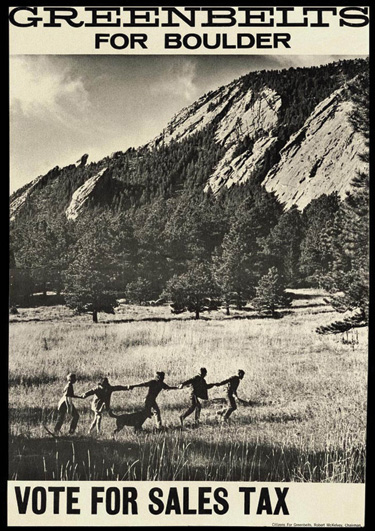On Tuesday (Nov. 1), City Council will consider landmark designation for the home of the late Albert and Eleanor Bartlett. Their children have generously applied to landmark the 99-year old home, preserving their parent’s legacy forever.

Greenbelt campaign poster. Original photo by Hal Malde.
Among the many contributions to science, the environment and the Boulder community that Physics Professor Emeritus Al Bartlett made, the one he was probably best known for internationally is his celebrated lecture on Arithmetic, Population and Energy, which pointed out that over time, compounded growth could yield enormous increases and that over-population was the greatest challenge facing humanity. Locally, he is fondly remembered for his efforts on:
The Blue Line Amendment, 1958
Al’s environmental activism began soon after he joined the faculty at CU in 1950. In 1958, when his friend Bob McKelvey, another CU faculty member, hailed him down on the CU campus and said, “Al, something has to be done on those foothills or they will be covered with houses.” Al agreed and asked if he had a suggestion to which Bob replied, “Setting a line above which the City will not furnish water or other services.” And thus began the groundwork and organizing for the Blue Line Amendment (passed in 1958) which prohibits water service above a certain elevation.
PLAN-Boulder County, 1959
Founded by Al and several other citizens with environmental interests who had worked to pass the Blue Line, the People’s League for Action Now (“PLAN-Boulder”) was formed “in response to an awakening understanding that the attractiveness and individual character of our town are in serious jeopardy.” Some of the goals of the founding members were to: “combat sprawl with green areas, make a pleasant trail along Boulder Creek, have a long-range program for park acquisition, insure that newly developed areas more nearly pay their way.”
National Center for Atmospheric Research, 1961
Al served on the Natural Area Committee of CU when NCAR proposed the development of their labs on Table Mountain, a site above the Blue Line. After the committee submitted a detailed report for preservation of the area along the Flatirons Mesa Trail, PLAN-Boulder received a letter from NCAR’s director Walter Orr Roberts that the western portion of the site was to be kept in its undeveloped natural state with free access to the public. PLAN-Boulder and other groups agreed to the exception for water above the Blue Line and the voters approved the exception to the Blue Line amendment in 1961.
Enchanted Mesa, 1963
In the early 1960s, the owners of Enchanted Mesa, which lies adjacent to Chautauqua, announced a plan to develop a resort hotel and homes on the site. PLAN-Boulder rallied to save the Mesa for the public. Al suggested a picnic and guided tours of the site with the intent to float a proposal for a bond issue to buy the 155 acre site. Posters of a beautiful photo of the Mesa taken by Oakleigh Thorne were displayed across town and the bond measure passed by a narrow margin in 1963.
Open Space, 1967
Al and members of PLAN-Boulder, chaired by Ruth Wright, initiated a citizens’ effort to tax themselves to purchase and preserve open space for Greenbelts in Boulder. Its approval at the polls made national news and this step led to the formation of the City of Boulder’s beloved Open Space program.
Bikeways for Boulder, 1968
Boulder’s extensive network of bikeways grew from Al’s concern that his children didn’t have a safe way to bike to Columbine School. Al and others met to formulate a detailed proposal for Planning Board and City Council to create a network of 22 strategic bikeways around the city and PLAN-Boulder circulated thousands of petitions to school children to give to the City Manager, who was then so flooded with petitions he sent out an SOS – “Call off your kids!” In November 1971, Bikeways for Boulder Day was celebrated with 500 cyclists in Central Park to impress a rally of Council candidates. Boulder’s renowned bikeway system has followed from those initial efforts.
Boulder’s environmental stewardship, compact form, preserved natural beauty, and walk-and bike-ability are unique in the nation because of these early efforts. Where would Boulder be without Al Bartlett and others of his generation who had the vision and passion to make it happen? Our hats are off to Al Bartlett and his family for the wonderful legacy they’ve left us in Boulder.
For more info go to www.albartlett.org and www.planboulder.org




 (3 votes, average: 3.67 out of 5)
(3 votes, average: 3.67 out of 5)